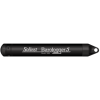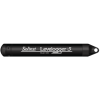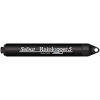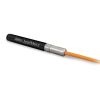Solinst Levelogger 5 LTC Water Level & Conductivity Loggers
Features
- Increased memory for logging up to 100,000 sets of data
- Upgraded platinum RTD and conductivity sensor for better sensitivity
- Double O-ring seals with 2x over pressurization rating
- Free ground shipping
- Expedited repair and warranty service
- Lifetime technical support
- More
Overview
The Solinst Levelogger 5 LTC combines a datalogger, 8-year battery, Hastelloy pressure sensor, temperature detector, and conductivity sensor within a small waterproof housing, 22mm x 208mm (7/8" x 8.2"). A baked-on coating using polymerization technology protects the body against corrosion, abrasion and high temperatures. The conductivity sensor is a 4-electrode platinum sensor with autoranging capabilities. The minimal-maintenance, sealed Levelogger 5 LTC is simple to clean and calibrate, even in the field.
Level Sensor: Piezoresistive Silicon with Hastelloy Sensor
Ranges: 5, 10, 20, 30, 100, and 200 m
Accuracy: ±0.05% FS
Resolution: 0.001% FS to 0.0006% FS
Units of Measure: cm, m, ft, psi, kPa, bar (ºC, ºF)
Normalization: Automatic Temperature Compensation
Temp Comp. Range: 0ºC to 50ºC
Temperature Sensor: Platinum Resistance Temperature Detector (RTD)
Accuracy: ±0.05ºC
Resolution: 0.003ºC
Conductivity Sensor: 4-Electrode Platinum
Full Range: 0 – 100,000 µS/cm
Calibrated Range: 50 – 80,000 µS/cm
Accuracy: ±1%: 5,000 µS/cm – 80,000 µS/cm; greater of ±2% or 15 µS/cm: 50 µS/cm –5,000 µS/cm
Resolution: ±0.1 µS/cm
Temp Comp. Range: 0ºC – 50ºC
Normalization: Specific Conductance @ 25˚C
Battery Life: 8 Years (1 reading every 5 minutes)
Clock Accuracy (typical): ±1 minute/year (-20ºC to 80ºC)
Operating Temperature: -20ºC to 80ºC
Maximum Readings: 100,000 sets of readings
Memory: Slate or Continuous
Communication: Optical high-speed: 57,600 bps with USB
Size: 22 mm x 208 mm (7/8" x 8.2")
Weight: 197 grams (6.95 oz)
Corrosion Resistance: Baked-on coating using polymerization
Wetted Materials: Platinum, Delrin®, Viton®, 316L Stainless Steel, Hastelloy, Regulator approved PFAS-free PTFE
(inside and out)
Sampling Mode: Linear, Event & User-Selectable with Repeat Mode, Future Start, Future Stop, Real-Time View
Measurement Rates: 2 seconds to 99 hours
Barometric Compensation: Software Wizard and Barologger 5
In The News
Sargassum Surge: How Seaweed is Transforming our Oceans and Coastal Ecosystems
Until recently, Sargassum –a free-floating seaweed–was distributed throughout the Sargasso Sea , the north Caribbean Sea, and the Gulf of Mexico. But in the space of a decade, this seaweed has, as one scientist remarks , “Gone from a nonfactor to the source of a terrible crisis.” Driven by climate change, anomalous North Atlantic Oscillation in 2009-2010 and a glut of anthropogenic pollutants, sargassum has proliferated. Seasonally recurrent mats as deep as 7m now bloom in the “Great Atlantic Sargassum Belt” (GASB), which covers areas of the Atlantic from West Africa to the Caribbean Sea and Gulf of Mexico. Every year, millions of tons wash up along the shores of more than 30 countries . Dr.
Read MoreGreat Lakes Research Center: Designing Targeted Monitoring Solutions
According to the National Oceanic and Atmospheric Administration ( NOAA ), the Great Lakes have more miles of coastline than the contiguous Atlantic and Pacific coasts combined and contain 20 percent of the world's freshwater, making it a critical region to protect and conserve. Continuous monitoring and data-informed resource management are key components of managing waters in the region. Hayden Henderson, a research engineer with the Great Lakes Research Center (GLRC), designs and deploys monitoring platforms throughout the Great Lakes. With a background in environmental engineering, Henderson enjoyed the challenge of creating systems and making them work to obtain difficult, remote measurements.
Read MoreMonitoring Meadowbrook Creek: Real-Time Data Collection in an Urban Creek
Meadowbrook Creek in Syracuse, New York, has been monitored by Syracuse University (SU) faculty and students for over a decade. Originally established by Dr. Laura Lautz in 2012, the early years of the program focused on collecting grab water samples for laboratory analysis and evaluating the impact of urban land use, human activities, and natural processes on water resources. Tao Wen , an Assistant Professor in SU’s Department of Earth and Environmental Sciences, took over the program in 2020 and upgraded the existing systems to include 4G modems that allowed for real-time data viewing. [caption id="attachment_39339" align="alignnone" width="940"] An overview of the Fellows Ave monitoring station along Meadowbrook Creek.
Read More



































































